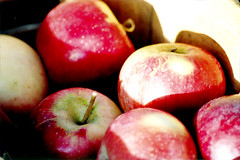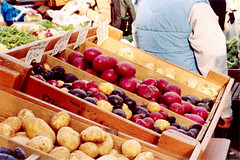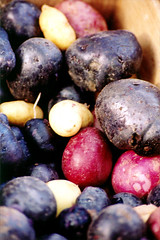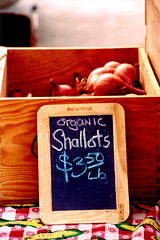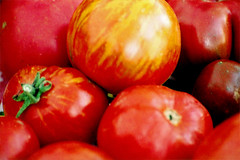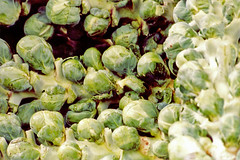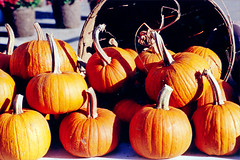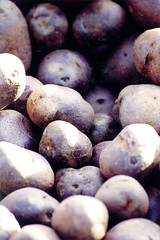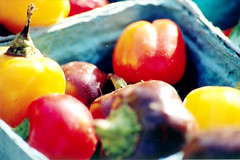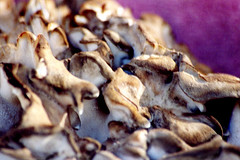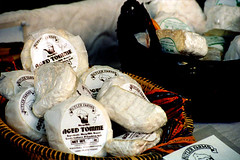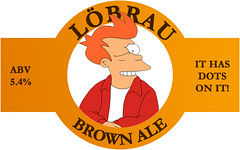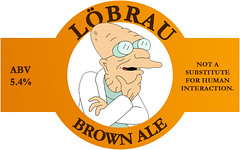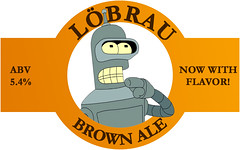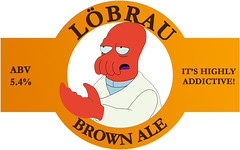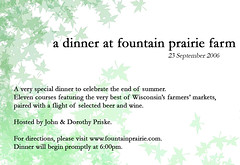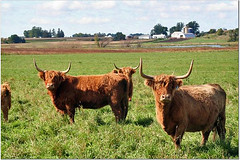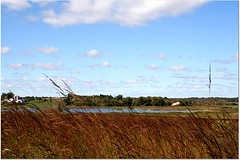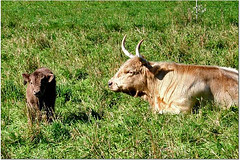Madison.
Eleven courses? You bet. Granted, actual professionals might not count the amuses-bouche as "courses", but I put a lot of thought and effort into this whole thing. Plus, eleven sounds all sorts of impressive. Aside from Ferrán Adrià-style
1 wackiness, where you might expect forty courses (most of which are hardly more than a spoonful
2 of something highly unusual), it's not something you'd really expect to see.
And when you tell everyone the eleven-course plan, sans details, I think it sets them up for the unexpected. The possibilities are so open that second-guessing the menu is all but impossible, and, I'll admit, that was fun.
Given that we had both omnivores and vegetarians (of varying stripes) coming to dinner, I had to plan on a primarily vegetarian dinner with meatless alternates that didn't feel like a copout. Below, I'll outline each course in detail
3, with images of the printed menus posted at the end. (Note that I had to print menus before purchasing the last ingredients at the market that morning, so things were apt to change last-minute.)
one - appetizerRoast beef tenderloin "BLT" or
Shiitake mushroom "BLT"The BLT is perhaps the greatest sandwich template ever, a minimalist approach to sandwich construction that - when made well - is all about balance. I love the BLT.
This was a twist on that, layering together a slice of toasted sourdough baguette, a thin layer of fresh sheep's-milk brebis cheese, a few arugula leaves, an oven-roasted, slightly caramelized tomato half, a slice of beef tenderloin that I'd seared to just rare, and a few thai basil leaves. I'd originally thought of roasting a larger portion of tenderloin - even earlier than that, I'd strongly considered smoke-roasting, but had to nix that when the weather wouldn't cooperate - but a hot pan on the stovetop was simpler to manage. To keep the rich meatiness, I gave the vegetarians some pan-seared shiitake caps instead of the beef.
Parker pear BelliniI don't recall even seeing local peaches this year, which would have been the traditional choice for Bellinis. Even so, I'd wanted to use something more local, and settled on pureed Parker pears since the phenomenal Moonglows wouldn't be ready in time. Just a few spoonfuls of pear in each glass, topped off with some slightly sweet sparkling wine (Lunetta Prosecco), and they were ready.
two - saladSalad of fresh and pickled fruits and vegetablesAs far as I'm concerned, there's a rare meal that wouldn't benefit from including some pickles. The Koreans have it just right, serving some kimchi alongside just about everything. Salty, sour, with opportunities for sweet and spicy, they can add some zip to just about anything. They can also be made well ahead and - if canned properly - kept in the basement.
I went with two different types of pickles: a sweet, garlicky pairing of mini bell peppers and cucumber slices; and some shredded carrots with some bright red
4 jalapeno peppers. I'd originally intended to serve these on a bed of heirloom tomato slices, but it was a little too late in the season. Instead, I picked up some Beauty Heart radishes and a variety of cherry and currant tomatoes, then topped it all with some mountain mint and fresh black pepper.
three - soupSmoked tomato soup with cheddar crackersFor much of this meal, I tried to take something standard and revise it to include something just a little unusual. SUre, I could have tried to create something completely new, but it's such dangerous territory - especially when feeding a crowd - that I've no confidence in pulling it off. This was a variation on the classic comfort food of grilled cheese sandwiches and tomato soup, a combination that I knew worked and could stand a dash of sophistication.
5I cold-smoked some meaty, red tomatoes with hickory and then slow-roasted them in a moderate oven to get a smoky, intensified tomato flavor. The rest of the soup simply included sweet onions, softened in butter, carrots and water, all simmered together and passed through a food mill for a smoother texture. Some scallion greens, thinly sliced, made for a quick garnish.
The accompanying crackers, made with aged cheddar and sweet constantine, are a recipe I'd discovered last winter, in preparation for a wine and cheese party. Baked a day ahead and reheated just before serving, they were like miniature sandwiches, small enough to dip into the little bowls of soup.
Unibroue 'Maudite' red ale, Quebec, CanadaWine is often paired with meals - especially haute cuisine - while we tend to relegate beer to more everyday fare. Beer, though, can be amazingly versatile with food, and it's something that I know better than wine. Some experimentation led me to Maudite, a beer from the
Unibroue brewery in Chambly, Quebec. Known for their Belgian-style ales, they produce a variety of bottle-conditioned beers that are rather unusual. Maudite - the name and label are based on
the québécois legend of La Chasse-galerie, or Flying Canoe - is a distinctive, complex beer that, to me, really worked well with the smokiness of the soup.
four - pastaRicotta, hickory nut and onion ravioli with roasted tomatillo and poblano chilli sauceHandmade ravioli featured a rich egg pasta, stuffed with a combination of ricotta, ground hickory nuts, and caramelized red onions. Made ahead and carefully frozen, I knew that they could be both impressive and require a minimum of labor at dinnertime. As they were primarily a combination of rich, sweet ingredients, I sauced them with a puree of roasted tomatillos and roasted poblano peppers for some brightness and just a little chilli heat.
five - amuse-boucheThree tea jellies: Darjeeling black with orange; Ban-cha green with honey; Cascade hopAn excuse to use hops in a non-beer way, I wanted to create some simple jellies to feature various infusions. Since I wanted to ensure that my vegetarian option was truly that, I opted for pectin-based jellies, rather than using gelatin. This meant that I needed a base level of sweetness from the sugar necessary to set the pectin, which was a limiting factor in the perceptible bitterness.
I served them on water crackers, for simplicity's sake. The Darjeeling, a black tea, took an even seat with the fresh-squeezed orange juice in a rather sweet jelly. I flavored ban-cha, a slightly smoky, roasted green tea, with honey, like I might at home. The cascade, being such an unusual flavor, I left on its own, and the sugar helped tame the sometimes overwhelming bitterness that a pure hop infusion can have.
six - seafood/terrineTerrine of shrimp, cured trout, leeks and mushrooms with basil cream sauce or
Terrine of late-summer vegetables and goat cheese with basil cream sauceThis was the second of three courses that separated the main and vegetarian menus. Again, looking for make-ahead options, I decided to prepare two separate terrines that could simply be sliced, plated and served. The seafood terrine featured a smooth puree of shrimp, cream and egg, folded with sauteed crimini mushrooms and leeks, and layered with freshly cured trout. For the trout, I used a simple cure of salt and sugar, with some black pepper, garlic and bourbon for additional flavor. I used swiss chard leaves to wrap the vegetarian terrine, which consisted of layers of fresh goat's milk chevre, brightly colored slices of heirloom tomatoes, red bell pepper and yellow wax beans.
Alongside, I served oven-roasted crimini mushrooms and a foamed sauce of basil-infused yogurt and cream. By mixing yogurt and cream in equal proportions, I was able to whip it into a soft, tangy version of whipped cream, tinged pale green from the basil.
Fred Loimer 'Lois' grüner veltliner, 2005, AustriaChosen to match the seafood, I included a minerally grüner veltliner. Light, with a bit of a sweet edge, it was a straightforward, clean wine that I'd hoped could pair equally well with both fish and fresh vegetables.
seven - meat/mainChicken sausage with sour cherry and sage; pork sausage with roasted pepper and basil; with polenta and fresh salsa or
Succotash of polenta, fresh beans, and spicy roasted squash, with fresh salsaThe last of the split courses, this was the largest and most complicated. I saw it as the feature of the meal, both as the main course and as a chance to try to show off. Hence it came out on the only large plates used in the entire dinner.
The homemade sausages were a chicken sausage (flavored with pork fat, sour cherries, fresh sage and black pepper) and a pork sausage (flavored with roasted yellow bell pepper, fresh basil, black pepper, dried red pepper flakes and apple cider), poached and seared just prior to serving. The polenta I studded with fresh sweetcorn and cheddar cheese, and served it all with a trio of condiments: a fresh salsa of red onion, cherry and currant tomatoes, and lime juice; a coarse-grain mustard sweetened with apple cider and spiced with a little habanero pepper puree; and a garlicky aioli.
Vegetarians had my take on succotash, with the sweetcorn and cheddar polenta, roasted butternut squash smoothed out with a little cream and spiced with dried red pepper flakes, blanched dragon tongue snap beans, and a sprinkling of mixed bean sprouts, all arranged into a precarious tower. The same trio of salsa, mustard and aioli went along with.
Querceto Chianti Classico, 2004, ItalyA middle-of-the-road red wine, this had a softness and a fruitiness that I wanted to match the sausages, without the sort of tannic quality that would have been more appropriate with, say, a grilled steak. I'd also hoped, somewhat blindly, that it would fit reasonably well with the vegetarian option, which lacked the richness of the two sausages.
eight - amuse-boucheHoney-lavender italian soda with herbed shortbreadThe original idea for this had been to use strawberry and mint. The flavor worked well, but I had difficulty getting a syrup that dissolved instantly, without lumps. The syrup of lavender, honey and lemon was first intended for a dessert sorbet. Textural trouble caused me to adapt it for the sodas. A small amount of syrup mixed with club soda made for a sparkling, perfumed drink without the heads-on sweetness of most sodas.
Since a liquid-only course seemed a little thin, I wanted a small taste of something else to go with. Shortbread, in addition to being a fantastic cookie, has a distinct saltiness to counter the sugar. I included some fresh mexican marigold, an anise-scented herb, for an herbal contrast to the lavender in the soda.
nine - cheeseSelection of local, artisanal cheesesCould this have been any easier? I picked five intensely flavored cheeses at the market on Saturday morning, and served them with crackers. The best part, of course, was tasting them as I shopped.
Taylor Fladgate LBV port, 1999, Portugal; Glenmorangie 12-year "Port Wood Finish" Highland Scotch whisky, ScotlandI couldn't decide between port and scotch for an after-dinner drink, and figured that neither one would be an all-around crowd pleaser. They were intended to go along with the cheese and dessert courses, so port seemed an appropriate choice. The Taylor Fladgate late bottle vintage I'd had before; in fact, by a gift-giving fluke, Sharon and I had been able to enjoy two successive years' bottles. The scotch was also one I'd enjoyed before, and the second aging - in a used port pipe - gives it a rich depth that genuinely suggests port. Plus, scotch is genuinely fantastic.
ten - dessertChocolate torte with sour cherry jamHad I been able to get apricots this year, it might have been a Sachertorte.
6 Instead, I baked a chocolate genoise, and layered it with a mixture of sour cherry jam and Amaretto. To top it off, I covered it with a ganache flavored with almond extract. To serve, I drizzled each wedge with some homemade creme fraiche, sweetened and flavored with vanilla and almond extracts.
Johnson Brothers coffeeJust roasted the Thursday before, I served up some French press coffee from Johnson Brothers Coffee Roasters: a Fair Trade Organic Ethiopian Yirgacheffe, Medium Roast. This, of course, is because a French press, a freshly roasted coffee, and a medium Nordic roast
7 produces the best cup of coffee.
eleven - chocolateThree chocolates: Ancho chili truffle; Orange and coffee cream; Thyme and juniper jellyI like the number three; it seems like a variety without being over the top. Or requiring too much effort. Also, truffle, cream and jelly were the three major types of filled chocolates that occurred to me. Ancho chilli, with a bit of cinnamon, is a great combination with chocolate, rich and sweet and without any significant heat. Coffee and orange take well to cream, even if the fondant filling doesn't have any actual dairy in it. And a thyme and juniper simply struck me as an unusual combination worth trying. Like hops and lavender, juniper is an uncommon flavor that I'd just as soon use more regularly.
The menus

* * * * *
Related posts:
Summary.Planning and Event.As Local As Possible.* * * * *
1The chef of Spain's El Bulli and de facto father of the "molecular gastronomy" movement - the "better living through chemistry" faction of cooking.
2Or beakerful, or syringeful, or whatever. Sometimes it seems like culinary Dada.
3Irritatingly specific and nitpicky detail.
4The ripe version, which I don't see very often.
5Or pretentiousness. It can be a pretty fine line, and I'm a clumsy guy.
6Something like a Sachertorte, at any rate. Since the recipe's a closely guarded secret, and I've never been to the Hotel Sacher, I can only guess at what it's really like.
7And a coffee that's good enough to stand up to that low level roasting. By expert estimates, that's less than 2% of world coffee production, and it's an important reason to know your coffee roaster.

